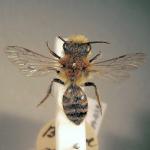Andrena rufitarsis KIRBY 1802
One of a group of five generally distinctive summer-flying species, females of which all have the hind tibiae widest at the apex (i.e. triangular in outline), not before the apex, as in the vast majority of Andrena. The abdomens of these species have distinct, wide bands of long hairs on each dorsal segment, giving them a rather furry appearance overall. Separating the species within the group is rather more difficult, especially for males.
More pictures and notes can be found on Steven Falk's Flickr site.
A very rare bee in the UK, with confirmed records from Dorset and Suffolk only. Unconfirmed records are from South Hampshire, Essex and Norfolk. The last known sighting was in Dorset in 1944. It is local and scarce in Europe, although records are well-dispersed in the central regions of the continent.
Listed in Shirt (1987) as Endangered (RDB1) and by Falk (1991) as Vulnerable (RDB2). It is possible that the true situation may be that it is extinct.
No details known, but several other members of this group are closely associated with the flowers of Asteraceae. The known areas have sandy soils present (in Suffolk), or nearby (at Norden, near Corfe, Dorset).
Univoltine: July to August
Unknown.
Purple loosestrife (Lythrum salicaria), ragwort (Senecio jacobaea), smooth hawk's-beard (Crepis capillaris).
None known.
2006


